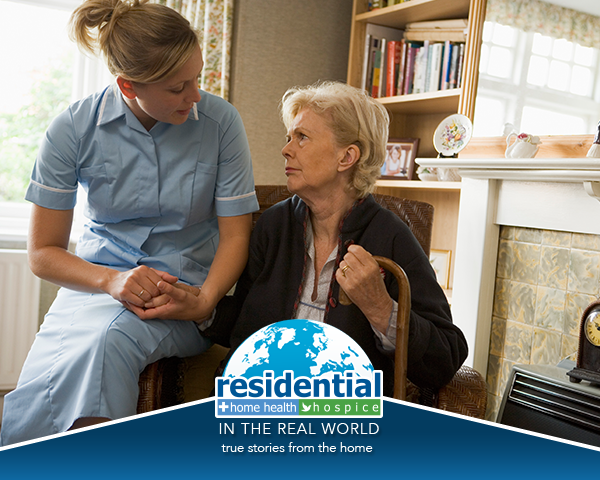 In a perfect world, home health care would progress without any setbacks. Improvements would happen exactly as planned, on schedule, without interruption. And health scares — related or not to a patient’s chronic illness — would be unheard of.
In a perfect world, home health care would progress without any setbacks. Improvements would happen exactly as planned, on schedule, without interruption. And health scares — related or not to a patient’s chronic illness — would be unheard of.
In the real world, however, health is a little trickier to maintain, especially at home. There’s so much to manage: home hazards, medication dangers, financial matters….Even when someone’s health and strength is progressing well at home, there’s no guarantee that a sudden symptom or warning sign won’t pop up. For Residential physical therapist Kimberly, her patient was appearing to do just great, until, just as quickly, she wasn’t. But Kimberly’s medical expertise and calm approach allowed her to recognize the red flags and summon emergency help. Her story of wise clinical judgment and speedy action shows the value of urgent treatment when a stroke is suspected, possibly even reducing the extent of injury.
Sudden Telltale Signs
Mary had been receiving home health care to build up strength and combat the effects of vertigo, an inner-ear disorder that can cause symptoms of dizziness and unsteadiness. It was the end of another routine physical therapy session with Kimberly; Mary’s vital signs had been normal and stable throughout their visit, without any troublesome symptoms. But as Kimberly was cleaning equipment and getting ready to leave, the patient showed a sudden onset of slurred speech and was having difficulty finding her words. Clearly anxious about the sudden loss of speech, Mary tried taking deep breaths to relax, but she continued to have trouble speaking.
Kimberly remained calm and sat in front of her patient. She asked Mary to smile, and noted slight facial drooping on the right side; she asked Mary to raise both arms overhead, and did not note any weakness on either side; finally, she asked Mary to state her name, and the patient could not do so clearly. Kimberly’s clinical judgment told her that her patient may be having a stroke.
Time for Emergency Help
When Kimberly stated that she would call 911 for further assessment, Mary grew upset and anxious. She absolutely did not want to go back to the hospital — she was progressing well with her therapy and did not want any setbacks. Remaining calm, Kimberly reassured the patient that it was important to get the right medical attention quickly. The 911 dispatcher had Kimberly perform similar tests according to protocol for strokes, and again Mary could not pronounce a simple sentence. An ambulance was sent immediately.
The paramedics arrived quickly, and Kimberly was able to speak on Mary’s behalf, giving the responders information about the timing of Mary’s symptoms and her normal ‘baseline’ level. Grabbing the patient’s Residential Home Health binder, Kimberly knew just where to find a list of her medications and a summary of past medical history to give to the paramedics. Mary was anxious and nervous at being unable to verbalize her needs, so Kimberly remained by her side until she was taken to the hospital.
No Loss of Function
Kimberly felt fortunate to have been with her patient at that precise time so she could get her the right medical attention quickly. Had she not been there, Mary’s symptoms could have gone unnoticed and progressed to a life-threatening stroke. Instead, because Kimberly recognized the importance of rapid medical attention, Mary was a good candidate for treatment with a drug called tPA, which can diminish the potential effects of a suspected stroke if taken early. Brain imaging done at the hospital showed a possible ‘mini-stroke’ (known as TIA), but not a stroke itself. After just five days in the hospital, Mary returned home with the same level of function that she had previously.
Mary was grateful to return home so quickly, able to continue with her therapy and work toward her goals. Her Residential Home Health Care Team continued with the patient’s plan of care, and both Kimberly and nurse Kathy educated Mary about the signs and symptoms of stroke/TIA and the importance of getting immediate help. With hard work and continued progress, Mary was able to regain independent function at home without an assistive device, and was even given clearance to drive again by her doctor. By getting emergency care when appropriate and offering a ‘voice’ for her patient, Kimberly likely spared Mary from further injury and vastly shortened her recovery time — getting her back on track and able to reach her goal of independent living.
No matter what your health challenge, Residential Home Health offers a range of services to help you work toward your health goals safely at home. Call (888)930-WELL (9355) to discuss your specific situation with a Home Care Specialist today, or click the image below to take our 60-second, 15-question Home Care Assessment.
{{cta(‘3073a01b-4a0b-41c6-91c0-460ecd8e3277′,’justifycenter’)}}

